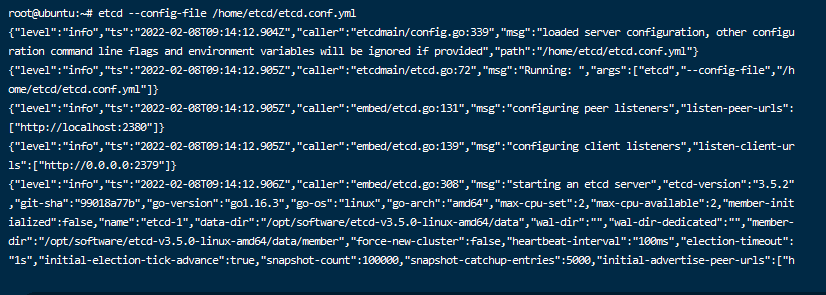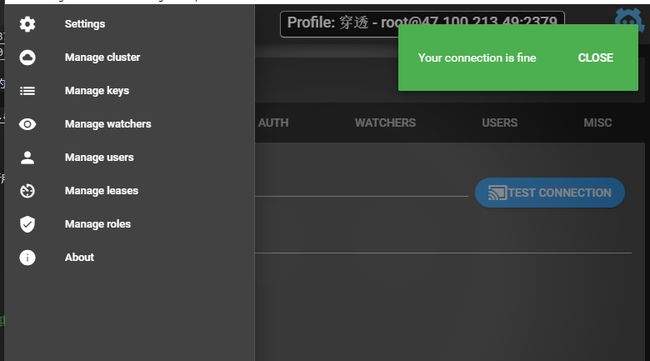不使用pvc的方式在K8S中部署apisix-gateway
简介
我的apisix使用etcd作为数据存储服务器,官方的使用pvc方式或者docker-compose的方式,对于新手不太友好,本篇是从etcd的安装到apisix的打通都会涉及。
部署etcd
etcd 是一个分布式键值对存储,设计用来可靠而快速的保存关键数据并提供访问。通过分布式锁,leader选举和写屏障(write barriers)来实现可靠的分布式协作。etcd集群是为高可用,持久性数据存储和检索而准备。
-
ubuntu部署etcd
-
ubuntu中部署etcd的两种方式:
一种是去GitHub下载二进制的安装包,还有一种是apt-get install etcd,第二种方式我也尝试过,可能是我软件源的问题,版本有点老,所以我就换成了使用第一种方式,而且也比较推荐使用第一种方式。
-
我用的etcd下载的版本是3.5.2,废话不多说直接看步骤:
1、将etcd etcdctl etcdutl 二进制文件拷贝到/usr/local/bin目录下
/usr/local/bin2、创建一个etcd的etcd.conf.yml,将下面代码拷贝进去,我这里etcd就简单的配置了一下,没有做集群,所以yml很简单。
name: etcd-1 data-dir: /home/etcd/data listen-client-urls: http://0.0.0.0:2379 advertise-client-urls: http://0.0.0.0:23793、通过etcd --config-file etcd.conf.yml的路径运行,如下图就是成功了,也可以使用etcd manager客户端来测试。


4、如果使用etcd直接启动的话没有办法后台运行,所以我们需要在/etc/systemd/system目录下创建一个etcd.service来进行后台运行。
[Unit] Description=ETCD Server Documentation=https://github.com/coreos/etcd After=network-online.target Wants=network-online.target [Service] User=root Group=root ExecStart= etcd --config-file /home/etcd/etcd.conf.yml [Install] WantedBy=multi-user.target5、创建好之后可以通过以下命令来确定运行状态如下图:
# 启动 sudo systemctl start etcd.service # 查看状态 sudo systemctl status etcd.service # 开机自启 sudo systemctl enable etcd.service# 设置版本为V3 export ETCDCTL_API=3 # 添加用户 etcdctl user add root # 开启认证 etcdctl auth enable
-
K8S部署apisix
apisix-gateway在部署的时候分为两块,分别是apisix和apisix-dashboard面板,所以看起来比较绕,不过apisix在部署的时候使用的是yaml文件覆盖的方式,所以我这里是将yaml存储到configmap中了,方便进行统一管理。我使用的k8s是Ubuntu出品的microk8s,用它的主要原因是因为配置简单。
- apisix是服务端,用来进行网络请求转发。
- apisix-dashboard是他的控制面板,用来进行可视化配置。
-
apisix介绍
apisix是基于 OpenResty + etcd 实现的云原生、高性能、可扩展的微服务 API 网关。它是国人开源,目前已经进入 Apache 进行孵化。APISIX 通过插件机制,提供了动态负载平衡、身份验证、限流限速等等功能,当然我们也可以自己开发插件进行拓展。
- 动态负载均衡:跨多个上游服务的动态负载均衡,目前已支持 round-robin 轮询和一致性哈希算法。
- 身份验证:支持 key-auth、JWT、basic-auth、wolf-rbac 等多种认证方式。
- 限流限速:可以基于速率、请求数、并发等维度限制。
-
部署apisix
1、创建apisix.conf.yaml,并存储到configmap中,
apisix: node_listen: 9080 # APISIX listening port enable_ipv6: false allow_admin: # http://nginx.org/en/docs/http/ngx_http_access_module.html#allow - 0.0.0.0/0 # We need to restrict ip access rules for security. 0.0.0.0/0 is for test. admin_key: - name: "admin" key: edd1c9f034335f136f87ad84b625c8f1 role: admin # admin: manage all configuration data # viewer: only can view configuration data - name: "viewer" key: 4054f7cf07e344346cd3f287985e76a2 role: viewer enable_control: true control: ip: "0.0.0.0" port: 9092 etcd: host: # supports defining multiple etcd host addresses for an etcd cluster - "http://192.168.31.170:2379" user: "root" # ignore etcd username if not enable etcd auth password: "root" # ignore etcd password if not enable etcd auth discovery: nacos: host: - "http://47.100.213.49:8848" prefix: "/nacos/v1/" fetch_interval: 30 # default 30 sec weight: 100 # default 100 timeout: connect: 2000 # default 2000 ms send: 2000 # default 2000 ms read: 5000 # default 5000 ms plugin_attr: prometheus: export_addr: ip: "0.0.0.0" port: 9091 plugins: - client-control - ext-plugin-pre-req - zipkin - request-id - fault-injection - serverless-pre-function - batch-requests - cors - ip-restriction - ua-restriction - referer-restriction - uri-blocker - request-validation - openid-connect - wolf-rbac - hmac-auth - basic-auth - jwt-auth - key-auth - consumer-restriction - authz-keycloak - proxy-mirror - proxy-cache - proxy-rewrite - api-breaker - limit-conn - limit-count - limit-req - gzip - server-info - traffic-split - redirect - response-rewrite - grpc-transcode - prometheus - echo - http-logger - sls-logger - tcp-logger - kafka-logger - syslog - udp-logger - serverless-post-function - ext-plugin-post-req stream_plugins: - ip-restriction - limit-conn - mqtt-proxy2、使用kubectl命令创建configmap
kubectl create configmap sukt-apisix-gateway-config --from-file=config.yaml=/home/sukt-platform/apisix/apisix-gateway-config.yaml -n sukt-platform3、新建apisix-deployment.yaml
apiVersion: apps/v1 kind: Deployment metadata: name: sukt-apisix-gateway namespace: sukt-platform spec: selector: matchLabels: app: sukt-apisix-gateway template: metadata: labels: app: sukt-apisix-gateway spec: containers: - name: sukt-apisix-gateway image: apache/apisix:2.10.3-alpine imagePullPolicy: IfNotPresent resources: limits: cpu: 500m memory: 1Gi requests: cpu: 250m memory: 256Mi securityContext: privileged: false terminationMessagePath: /dev/termination-log terminationMessagePolicy: File volumeMounts: - mountPath: /usr/local/apisix/conf/config.yaml name: config subPath: config.yaml ports: - containerPort: 9080 - containerPort: 9443 dnsPolicy: ClusterFirst restartPolicy: Always schedulerName: default-scheduler securityContext: {} terminationGracePeriodSeconds: 30 volumes: - configMap: defaultMode: 420 name: sukt-apisix-gateway-config name: config4、新建apisix-service.yaml
apiVersion: v1 kind: Service metadata: name: sukt-apisix-gateway-nodetype labels: app: sukt-apisix-gateway-nodetype namespace: sukt-platform spec: type: NodePort selector: app: sukt-apisix-gateway ports: - port: 9080 name: transfer1 targetPort: 9080 nodePort: 30107 - port: 9443 name: transfer2 targetPort: 9443 nodePort: 30108 -
部署apisix-dashboard
1、创建apisix-dashboard-config.yaml,并存储到configmap中,
# # Licensed to the Apache Software Foundation (ASF) under one or more # contributor license agreements. See the NOTICE file distributed with # this work for additional information regarding copyright ownership. # The ASF licenses this file to You under the Apache License, Version 2.0 # (the "License"); you may not use this file except in compliance with # the License. You may obtain a copy of the License at # # http://www.apache.org/licenses/LICENSE-2.0 # # Unless required by applicable law or agreed to in writing, software # distributed under the License is distributed on an "AS IS" BASIS, # WITHOUT WARRANTIES OR CONDITIONS OF ANY KIND, either express or implied. # See the License for the specific language governing permissions and # limitations under the License. # conf: listen: host: 0.0.0.0 # `manager api` listening ip or host name port: 9000 # `manager api` listening port allow_list: # If we don't set any IP list, then any IP access is allowed by default. - 0.0.0.0/0 etcd: endpoints: # supports defining multiple etcd host addresses for an etcd cluster - "http://192.168.31.170:2379" # yamllint disable rule:comments-indentation # etcd basic auth info username: "root" # ignore etcd username if not enable etcd auth password: "root" # ignore etcd password if not enable etcd auth mtls: key_file: "" # Path of your self-signed client side key cert_file: "" # Path of your self-signed client side cert ca_file: "" # Path of your self-signed ca cert, the CA is used to sign callers' certificates # prefix: /apisix # apisix config's prefix in etcd, /apisix by default log: error_log: level: warn # supports levels, lower to higher: debug, info, warn, error, panic, fatal file_path: logs/error.log # supports relative path, absolute path, standard output # such as: logs/error.log, /tmp/logs/error.log, /dev/stdout, /dev/stderr access_log: file_path: logs/access.log # supports relative path, absolute path, standard output # such as: logs/access.log, /tmp/logs/access.log, /dev/stdout, /dev/stderr # log example: 2020-12-09T16:38:09.039+0800 INFO filter/logging.go:46 /apisix/admin/routes/r1 {"status": 401, "host": "127.0.0.1:9000", "query": "asdfsafd=adf&a=a", "requestId": "3d50ecb8-758c-46d1-af5b-cd9d1c820156", "latency": 0, "remoteIP": "127.0.0.1", "method": "PUT", "errs": []} authentication: secret: secret # secret for jwt token generation. # NOTE: Highly recommended to modify this value to protect `manager api`. # if it's default value, when `manager api` start, it will generate a random string to replace it. expire_time: 3600 # jwt token expire time, in second users: # yamllint enable rule:comments-indentation - username: admin # username and password for login `manager api` password: P@ssW0rd - username: user password: P@ssW0rd plugins: # plugin list (sorted in alphabetical order) - api-breaker - authz-keycloak - basic-auth - batch-requests - consumer-restriction - cors # - dubbo-proxy - echo # - error-log-logger # - example-plugin - fault-injection - grpc-transcode - hmac-auth - http-logger - ip-restriction - jwt-auth - kafka-logger - key-auth - limit-conn - limit-count - limit-req # - log-rotate # - node-status - openid-connect - prometheus - proxy-cache - proxy-mirror - proxy-rewrite - redirect - referer-restriction - request-id - request-validation - response-rewrite - serverless-post-function - serverless-pre-function # - skywalking - sls-logger - syslog - tcp-logger - udp-logger - uri-blocker - wolf-rbac - zipkin - server-info - traffic-split2、使用kubectl命令创建configmap
kubectl create configmap sukt-apisix-dashboard-config --from-file=config.yaml=/home/sukt-platform/apisix/apisix-dashboard-config.yaml -n sukt-platform3、新建apisix-dashboard-deployment.yaml
apiVersion: apps/v1 kind: Deployment metadata: name: sukt-apisix-dashboard namespace: sukt-platform spec: selector: matchLabels: app: sukt-apisix-dashboard template: metadata: labels: app: sukt-apisix-dashboard spec: nodeName: microk8sslave1 # 部署到指定的node节点 containers: - name: sukt-apisix-dashboard image: apache/apisix-dashboard:2.10.1-alpine imagePullPolicy: IfNotPresent resources: limits: cpu: 500m memory: 1Gi requests: cpu: 250m memory: 256Mi securityContext: privileged: false terminationMessagePath: /dev/termination-log terminationMessagePolicy: File volumeMounts: - mountPath: /usr/local/apisix-dashboard/conf/conf.yaml name: config subPath: config.yaml #这个位置对应的是comfigmap中的名字,不是 /usr/local/apisix-dashboard/conf/conf.yaml ports: - containerPort: 9000 dnsPolicy: ClusterFirst restartPolicy: Always schedulerName: default-scheduler securityContext: {} terminationGracePeriodSeconds: 30 volumes: - configMap: defaultMode: 420 name: sukt-apisix-dashboard-config name: config4、新建apisix-dashboard-service.yaml
apiVersion: v1 kind: Service metadata: name: sukt-apisix-dashboard-nodetype labels: app: sukt-apisix-dashboard-nodetype namespace: sukt-platform spec: type: NodePort selector: app: sukt-apisix-dashboard ports: - port: 9000 name: transfer1 targetPort: 9000 nodePort: 30109 -
运行效果图
-
结语
apisix-gateway文章分为两篇,本篇只是讲解了如何在k8s中安装以及启动,下一章讲解如何进行转发以及其他功能测试等。


